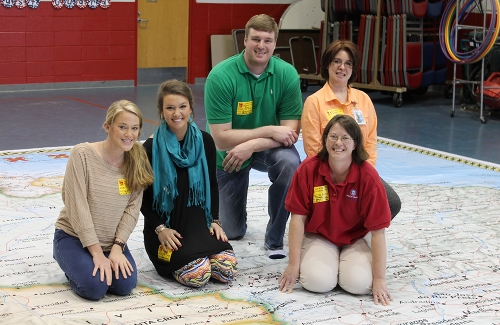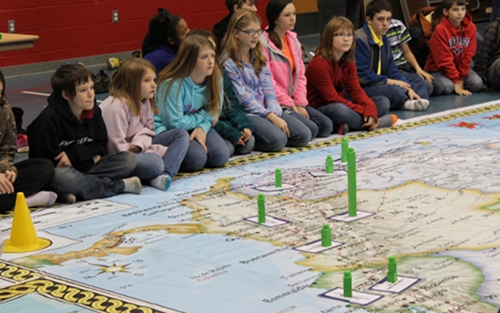
Ole Miss teacher candidates and more than 1,000 children at Lafayette County Elementary School had the chance to experience geography in a new and exciting way on February 24 and 25 with the arrival of the National Geographic Society’s Giant Traveling Map of South America.
The map, which measures 35 feet by 26 feet, is currently touring Mississippi and will visit Carroll County Schools on Wednesday and Strayhorn Elementary School in DeSoto County on Thursday where UM DeSoto teacher candidates and Strayhorn students will also complete activities to gain an appreciation of the geography of South America.
As a teaching tool, the map allows students to strengthen their geographic literacy of South America and is designed for grades K-8. The map comes with a variety of teaching accessories including interactive games, geography adventures, atlases and books that teach students about the physical characteristics of the continent as well as its rich history and varied cultures.

National Geographic’s Giant Traveling Maps program was introduced in 2006 with a map of Africa, and has since expanded to maps of North America, Asia, South America, and the Pacific Ocean. The map’s trip trough Mississippi during February was supported by the Mississippi Geographic Society at UM, the Mississippi Museum of Natural Science, the UM School of Education and the Mississippi State University College of Education.
To learn more about the Giant Traveling Map project or to download map activities, visit http://events.nationalgeographic.com/events/special-events/giant-traveling-maps/.
The National Geographic Society is one of the world’s largest nonprofit scientific and educational organizations. Founded in 1888 to “increase and diffuse geographic knowledge,” the Society’s mission is to inspire people to care about the planet. It reaches more than 400 million people worldwide each month through its official journal, National Geographic, and other magazines; National Geographic Channel; television documentaries; music; radio; films; books; DVDs; maps; exhibitions; live events; school publishing programs; interactive media; and merchandise. National Geographic has funded more than 9,600 scientific research, conservation and exploration projects and supports an education program promoting geographic literacy. For more information, visit nationalgeographic.com.
